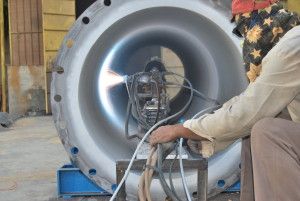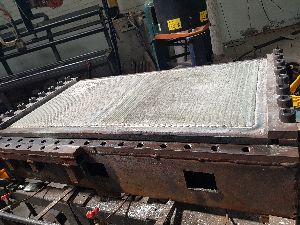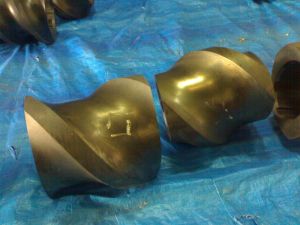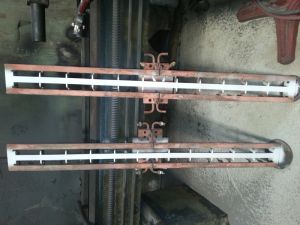
wire drum coating pulley
Country of Origin : India
Type : Tungsten Carbide Coating
Type : Thermal spay Coating
Type : Weld Had-facing
...more
Metallizing Spray Coating Service
Keepsake Engineering Consultancy Pvt. Ltd. provides excellent coating for shaft reclamation. We provide SS 304 coating over shaft which is a low temperature coating which does not affect the base material properties and doesn't distort the shaft. We are Service Provider of a wide range of services which include bearing journal coating, high velocity arc spray coating on furnace elbow, metal spray coating, metalizing, spray metalizing service and copper spray metallizing.
Speciality : Chemical Resistant, Waterproof, Water Resistant
Usage : Industrial Use,Reconditioning of Machine Part Against Wear like Abrasion, Corrosion, Erosion
Grade Standard : Industrial Grade
Type : Metal Spray Coating
Country of Origin : India
...more
vessel coating services
Vessel hard-facing by Coating/welding Service is rapidly emerging as a corrosion-resistant, chemical-resistant, Wear like abrasion, and erosion-resistant lining material to suit specific working conditions with reference to temperature, the type of materials, etc. Various grades of coating like ceramic, carbide, Hastalloy & peek, etc are available. The advantage of coating/weld lining is that along with this material can be fabricated into vessels, tanks, ducts, hoods, piping, impellers, housings, etc.
Country of Origin : Made In India
...more
Tungsten Carbide Coating
Tungsten Carbide Coatings are used in many wear applications like Abrasions, Erosion comes into the picture with various industrial components. The materials applied with this process give an extremely good life compared to not using them. This is an economical solution where maintenance cost, Components cost, and manufacturing cost go high. While tungsten carbide is a hard, brittle ceramic it is typically combined with Nickel, Cobalt and/or Chrome when used as a coating. This Cermet composite coating combines the ductility of the metallic material with the high hardness of the ceramic tungsten carbide which results in the excellent properties associated with this coating. Tungsten carbide can be applied using various processes including the detonation gun (d-gun) and high-velocity oxygen fuel (HVOF). Additionally, the HVOF thermal spray process results in relatively customizable coatings because the wear resistance, strength, and hardness depend on the volume fraction and grain size of the particles and on the types and ratios of the metallic binder used. This allows you to adapt the hardness and other properties of the carbide coatings to meet specific needs for a given item.
...more
TIG Welding Services with Super Alloys
Gas tungsten arc welding (GTAW), also known as tungsten inert gas (TIG) welding, is an arc welding process that uses a non-consumable tungsten electrode to produce the weld. The weld area is protected from atmospheric contamination by aninert shielding gas (argon or helium), and a filler metal is normally used, though some welds, known as autogenous welds, do not require it. A constant-current welding power supply produces energy which is conducted across the arc through a column of highly ionized gas and metal vapors known as a plasma.
...more
Thermal Spray Coating Services
In Ceramic coating, the feedstock material is fed continuously to the tip of the spray gun where it is melted in a fuel gas flame and propelled to the substrate in a stream of atomizing gas. Common fuel gas is acetylene. Air is typically used as the atomization gas.
...more
Thermal Spray Coating Service
Keepsake Engineering Consultancy Private Limited is a reliable company for thermal spray coating services. Thermal spray coating is a cost-effective way to protect critical components from wear, corrosion, fatigue, oxidation and high temperatures. It can be used to extend the service life and improve the performance of new parts before they go into operation, as well as restore worn parts. Our versatile thermal spray coating processes can apply a wide range of materials at different spray rates and coating thicknesses to meet your unique specifications. With our multi-axis robots and automated systems, we can create uniform thermal spray coatings on the most complex of geometries, delivering a high-quality coating that can withstand the harshest operating environments. High-temperature oxides, tungsten-carbide, chromium-carbide and copper-nickel-indium are just a few of the materials we can apply using one of our thermal spray technologies. Get our services today.
...more
stellite coating
This coating is used to produce magnetic, wear- and corrosion-resistant, and high-strength products, where temperature stability is important. Surface coating encompasses many different deposition techniques where the use of alloys based on cobalt powders is common, such as HVOF (High-Velocity Air Fuel), laser cladding, and plasma transferred arc (PTA). Stellite coatings can be obtained by many deposition techniques: plasma transferred arc (PTA) is certainly an optimal choice that gives thick, dense coatings, but thermalspray techniques like high velocity oxy-fuel (HVOF) are also widely used to deposit such materials. The present study investigates wear and mechanicalproperties of Stellite 6 deposited by cold spray in comparison to PTA-deposited Stellite 6, aiming to obtain a very dense coating without the dilution zone typically resulting from PTA weld surfaces.
Country of Origin : India
...more
Specialized Welding services

Screw Coating
Carbide coatings on Screw are typically used for wear resistance to abrasion, erosion, galling, and fretting. Most “carbide” coatings are applied by HVOF to achieve the densest and most well-bonded coatings available by thermal spray. For Higher Thickness, Weld Overlay of TIG, MIG or PTA or LASER process severe process application. There are several different chemistries of “carbide” coatings including:Types of Carbide CoatingsTungsten Carbide/CobaltTungsten Carbide/Nickel-ChromeChrome Carbide/Nickel-ChromeTungsten Carbide/Cobalt/ChromiumCarbide Coatings Resist:FrettingSliding WearErosionAbrasionGallingSome ImpactBenefits of Carbide CoatingsHigh Hardness, Durability And ToughnessAbrasion And Erosion ResistanceSome Corrosion ResistanceFretting ResistanceAnti-Galling PropertiesLong Lasting Traction Surface application.
...more
PEEK coating service
Polyether ether ketone (PEEK) is a high-temperature, high-performance thermoplastic special engineering plastics. It has good mechanical properties and resistance to chemicals, resistance to abrasion, resistance to hydrolysis and other properties. Its light weight, self-lubricating properties, good flow properties and processing properties can be filled with carbon fibre, graphite, molybdenum disulphide, etc. to further improve the lubricating properties and mechanical strength.
...more
Plasma Welding Service
Plasma arc welding (PAW) is an arc welding process similar to gas tungsten arc welding (GTAW). The electric arc is formed between an electrode (which is usually but not always made of sintered tungsten) and the work piece. The key difference from GTAW is that in PAW, by positioning the electrode within the body of the torch, the plasma arc can be separated from the shielding gas envelope. The plasma is then forced through a fine-bore copper nozzle which constricts the arc and the plasma exits the orifice at high velocities (approaching the speed of sound) and a temperature approaching 28,000 °C (50,000 °F) or higher. Arc plasma is the temporary state of a gas. The gas gets ionized after the passage of electric current through it and it becomes a conductor of electricity. In an ionized state, atoms break into electrons(-) and ions(+) and the system contains a mixture of ions, electrons, and highly excited atoms. The degree of ionization may be between 1% and greater than 100% i.e.; double and triple degrees of ionization. Such states exist as more electrons are pulled from their orbits. The energy of the plasma jet and thus the temperature is dependent upon the electrical power employed to create arc plasma. A typical value of temperature obtained in a plasma jet torch may be of the order of 50000 °F (28000 °C) against about 10000 °F (5500 °C) in an ordinary electric welding arc. Actually, all welding arcs are (partially ionized) plasmas, but the one in plasma arc welding is a constricted arc plasma. Plasma arc welding is an arc welding process wherein coalescence is produced by the heat obtained from a constricted arc setup between a tungsten/alloy tungsten electrode and the water-cooled (constricting) nozzle (non-transferred arc) or between a tungsten/alloy tungsten electrode and the job (transferred arc). The process employs two inert gases, one forms the arc plasma and the second shields the arc plasma. Filler metal may or may not be added.
...more
mig welding services
Gas metal arc welding (GMAW), sometimes referred to by its sub types metal inert gas (MIG) welding or metal active gas (MAG)welding, is a welding process in which an electric arc forms between a consumable wire electrode and the workpiece metal, which heats the workpiece metal, causing them to melt, and join. Along with the wire electrode, a shielding gas feeds through the welding gun, which shields the process from contaminants in the air. The process can be semi-automatic or automatic. A constant voltage, direct current power source is most commonly used with GMAW, but constant current systems, as well as alternating current, can be used. There are four primary methods of metal transfer in GMAW, called globular, short circuiting, spray, and pulsed-spray, each of which has distinct properties and corresponding advantages and limitations
...more
Laser Cladding Service
Cladding is a welding procedure that puts weld metal on the surface of the work, as opposed to joining two pieces of material. Generally, this is used for corrosion resistance or wear resistance and frequently a different material is used for the clad than for the base metal. In hot wire welding, the power supply controls the heat of the filler wire prior to its introduction into the weld puddle. Arc energy that would usually go into melting the wire provides more penetration, while heating of the wire almost to the melting point by a separate power supply increases deposition beyond that possible with standard cold wire TIG. In cladding applications where the part is rotated, the hot wire solution can result in weld deposition that approaches MIG speed, but with TIG quality. Laser cladding is realized either as wire (laser hot wire cladding) or powder cladding. The laser beam creates a molten pool at the workpiece surface, to which is simultaneously added the laser coating material (wire or powder) molten by the laser. The exposure time is short, which creates only a short delay as the cooling is quick. The result is a layer that is connected with the basic material metallurgically. It is tougher than those coatings created by thermal spraying, and compared to hard chromium plating, for example, it is harmless to health, too. Advantages: low exposure time and depth of the laser metallurgical connection of layer and basic material layers are more resistant than thermal spray coatings high surface quality and low warpage, with almost no post-processing necessary short laser cladding process period, high-energy efficiency
...more
hvof coating services
High-Velocity Oxygen Fuel (HVOF) coating is a thermal spray coating process used to improve or restore a component's surface properties or dimensions, thus extending equipment life by significantly increasing erosion and wear resistance, and corrosion protection. Coating thickness is usually in the range 0.1-2 mm. Characteristic features of HVOF sprayed coatings include their low level of porosity at about 1-2vol% and low oxide content in the range 1-2wt%. The bond strength often exceeds 80MPa. HVOF is same in theory to combustion flame spraying, but it uses a different torch design that enables the flame to expand when the spray nozzle is activated. This causes a surge in acceleration, which in turn accelerates the mixture particles. When the mixture is released from the nozzle, the velocity of the mixture leads to a very thin and evenly applied coat. The final coating is well adhered, strong, and dense. Its hardness, corrosion resistance, and overall wear resistance is superior to plasma spraying. Because of the low temperature of the torch flame, which both melts the powder and propels the coating's deposition, the mixture is not suited to withstanding high temperatures. thermal spray coatingHVOF Thermal Spray Coating benefits are: Reduced oxide content Reduced solutioning of carbides Neutral or compressive stress Smoother sprayed surface True coating uniformity Tensile band strength >10,000 psi
...more
high temperature ceramic coating
A metal object can be surface coated on the exposed area to achieve high wear, corrosion resistance, or thermal insulation. Surface coating can also be used to repair damaged parts. Complete part replacement is then unnecessary and this refurbishment effectively extends the lifetime of the part.
Country of Origin : India
Type : High Temperature Ceramic Coating
Grade Standard : Industrial Grade
Speciality : Chemical Resistant, Water Resistant, Optimum Quality, High Temperature Resistant
Usage : Industrial Use
...more
Ceramic Coatings on Plunger and Sleeve
Ceramic Coating can Improve Protection from Wear and are used for a wide range of Application in Paper Industries, Steel Industries, Textile Industries, Power Plants and Many More. In Ceramic coating, the feedstock material is fed continuously to the tip of the spray gun where it is melted in a fuel gas flame and propelled to the substrate in a stream of atomizing gas. Common fuel gas is acetylene. Air is typically used as the atomization gas.
Material : Metal
Application : Industrial
Type : Ceramics Balls,Sleeve
Country of Origin : India
...more
ceramic coating services
Flame spraying is a coating process using heat. A flame produces heat which is used to melt the thermal spray material, normally in powder, wire, or ceramic rod form. The molten particles are then propelled onto the surface to be sprayed, compressed air is used on the wire flame spray so that the molten particles are atomized and then propelled onto the substrate. When using the powder flame spray, the metal or ceramic powder particles are softened by the flame, then this softened powder is sprayed onto the surface to be coated by the use of the flame gases through the nozzle. With the wire flame spray process, the wire spray material is melted in a gaseous oxygen-fuel flame. The fuel gas can be acetylene, propane or hydrogen. The wire is fed concentrically into the flame, where it is melted and atomized by the addition of compressed air that also directs the melted material towards the workpiece surface. This coating process is based on the same operational principle as the wire flame spray process, with the difference that the coating material is a spray powder. Thus, a larger selection of spray materials is available, as not all spray materials can be manufactured in wire form. In Ceramic coating, the feedstock material is fed continuously to the tip of the spray gun where it is melted in a fuel gas flame and propelled to the substrate in a stream of atomizing gas. Common fuel gas is acetylene. Air is typically used as the atomization gas. Equipment: Ceramic coatings on pump equipment Name of the part: Ceramic Coated Sleeves and Plungers A major expense associated with pump operation is the replacement of sleeves/plungers. Wear on these components necessitates: Frequent packing adjustment to compensate for dimensional changes caused by wear. Packing material failure due to sleeve surface roughness. Premature pump stoppage due to leaks. Abrasion, Corrosion, and friction are the main causes of the problem The Solution we provide Coatings that provide a long-lasting wear-resistant surface using ceramic oxides or metallic carbides. We have a robotic Plasma transferred arc system (PTA) and flame spray equipment to apply coatings of tungsten carbide in a nickel chrome boron matrix and chromium oxides. The coating thickness is selected based on application wear potential and varies from 0.5mm to 1.5mm in thickness. For severe wear applications, PTA coated sleeves last longer. The Compositions used in ceramic coating are Chromium oxide, Alumina Titanium, Zirconia, Nickel alloys, Aluminium Bronze. Industries in which these parts are used are Thermal power plants, Sugar industries, Oil and gas sector and chemical process plants. These are our major consumers.
...more
carbide coatings
Carbide coatings are typically used for wear resistance to abrasion, erosion, galling, and fretting. Most “carbide” coatings are applied by HVOF to achieve the densest and most well-bonded coatings available by thermal spray. For Higher Thickness, Weld Overlay of TIG, MIG or PTA or LASER process severe process application. There are several different chemistries of “carbide” coatings including:Types of Carbide CoatingsTungsten Carbide/CobaltTungsten Carbide/Nickel-ChromeChrome Carbide/Nickel-ChromeTungsten Carbide/Cobalt/ChromiumCarbide Coatings Resist:FrettingSliding WearErosionAbrasionGallingSome ImpactBenefits of Carbide CoatingsHigh Hardness, Durability And ToughnessAbrasion And Erosion ResistanceSome Corrosion ResistanceFretting ResistanceAnti-Galling PropertiesLong Lasting Traction Surface application.
Texture : Hard
Surface Finishing : Powder Coated
Speciality : Chemical Resistant, Waterproof, Water Resistant, Optimum Quality, Wear Resistance
Usage : Industrial Use
Grade Standard : Industrial Grade
Type : Carbide Coatings
Country of Origin : India
Waterproof : Yes
...more
Spray And Fuse Coating Services
Oxy-acetylene welding torch with powder hopper and injection venturi mounted between a gas mixture and nozzle Powder falls through flame on a workplace where weld pool is maintained and the continuous bead is laid down. Spray and fuse use high heat to increase the bond between the thermal spray coating and the substrate of the part. Unlike other types of thermal spray, spray and fuse create a metallurgical bond between the coating and the surface. This means that instead of relying on friction for coating adhesion, it melds the surface and coating material into one material. Spray and fuse are the difference between adhesion and cohesion. Spray and Fuse Benefits Metallurgically bonded coating Hardface overlay alternative Hardchrome plating alternative Extreme wear resistance Spray and Fuse Materials Colmonoy® 88 Nickel-Cobalt Tungsten Carbide Nickel Chrome alloys Metco® 16C Spray and fuse are the best for... High-stress components Exhaust fans Sucker pump components Pump pistons Sleeves Plungers Ball Valve
...more
Ball valve coating
Country of Origin : India
Type : Water Ball Valves, Oil Ball Valves, Gas Ball Valves, Ball Valves, Ball Valve
Application : Water Fitting, Oil Fitting, Gas Fitting
Material : Stainless Steel
Pressure : Medium Pressure
Type : Ball Valve
Type : Seat
...more
Gate Valve coating
Country of Origin : India
Type : Gate Valves
Material : Stainless Steel
Temperature Pressure : Medium Temperature Pressure
Type : Gate valve
Type : Buterfly valve
...more
Blade coating
Type : Turbine Blades, Gas Turbine
Feature : Durable, Hard Structure

Cylinder Pipe coating services
Country of Origin : Made In India
Material : Mild Steel
Specialities : Durable
Usage : Marine Applications, Manufacturing Unit, Chemical Handlling, Steel Mill Rolls
Finishing : Coated
...moreBe first to Rate
Rate ThisOpening Hours